0 引言
煤的自热和自燃是导致煤炭火灾的常见原因[1]。煤自燃是一种比较复杂的现象[2],煤与氧气发生化学反应时会释放出热量,若这些热量没有及时驱散,会发生热量积聚,从而导致煤自燃。煤自燃可能发生于煤炭的开采、存储和运输过程中,开采过程中的煤自燃一般发生于地下煤层中,而存储和运输过程中的煤自燃一般发生于露天煤堆中。由于煤炭开采后存储和运输的时间较长,储煤堆自燃经常发生,造成了大量的经济损失和能源浪费。此外,煤自燃还会产生二氧化硫、氮氧化物、砷、镉、铬和铜等有毒有害物,严重危害人的生命健康和生态环境系统。因此,治理煤堆自燃对保护人员安全和生态环境等具有重要意义。
目前主要的煤堆自燃防治方法包括注水、注阻化剂、注浆、注凝胶泡沫等[3-4]。这些方法从隔氧、降温的角度出发,虽然能暂时阻止煤堆自燃的发生,却无法从根本上破坏煤堆内部的蓄热环境。重力热管作为一种高效的传热元件,由于结构简单、环保性强且工作性能优异,已被广泛应用于太阳能系统、工业余热回收等[5-7]。重力热管在煤自燃防治中的应用也引起了很多学者的关注。党逸峰等[8]研究了重力热管插入煤堆后对其内部温度的影响,验证了热管能够有效抑制煤堆升温。刘鑫等[9]采用不同工质液热管对不同水平煤堆的内部温度进行测定,发现工质液为甲醇时在100 mm和200 mm水平降温幅度较大,甲醇为最佳热管工质液。陈清华等[10]通过数值模拟建立了在煤堆中插入2根重力热管的数学模型。程方明等[11]通过数值模拟研究了在有热管和无热管插入煤堆情况下煤堆内部温度场变化,并建立了热管插入煤堆后的有效降温半径模型。李贝等[12]通过在矿场实验地布置热管和测点,发现热管对煤堆高温热源点温度产生了显著影响。王皎[13]利用数值模拟方式建立了风力驱动的三维非稳态煤堆自燃预测模型,并分析了重力热管布置深度和插入间距对大型煤堆温度场的影响。苏贺涛[14]利用重力热管的传热性质,建立了基于重力热管的煤火提热及温差发电系统,将煤火转化为可再利用的资源。
现有研究已得出重力热管的数量、插入深度和角度、充液率、工质液等会影响煤堆内部温度场的分布,但对重力热管在煤堆中的最佳布置方式的研究还比较少。鉴于此,本文基于重力热管传热理论模型,将热源等效为球体,通过数值模拟和实验相结合的方式,分析重力热管不同布置方式下煤堆内部温度的变化规律,并得出了重力热管的最佳布置方式。
1 重力热管工作原理
重力热管也称为两相闭式热虹吸管,由管壳和内部工质液组成,从几何结构上可分为蒸发段、绝热段和冷凝段[15],如图1所示。热管内部是具有一定真空状态的空间,由于工质液沸点较低,当热管底部受热后,蒸发段吸收热量,工质液沸腾并产生蒸气;高温蒸气在气压差的作用下沿着绝热段上升,到达热管冷凝段后,通过冷凝段管壳与外界空气对流换热;热管内部的高温蒸气受冷液化,在重力的作用下沿着绝热段回流到蒸发段,在热管两侧形成液膜,并将热源中的热量排出[16]。在这样的循环作用下,煤堆中高温处的热量被导出,无法积聚热量,从而抑制煤的自燃。
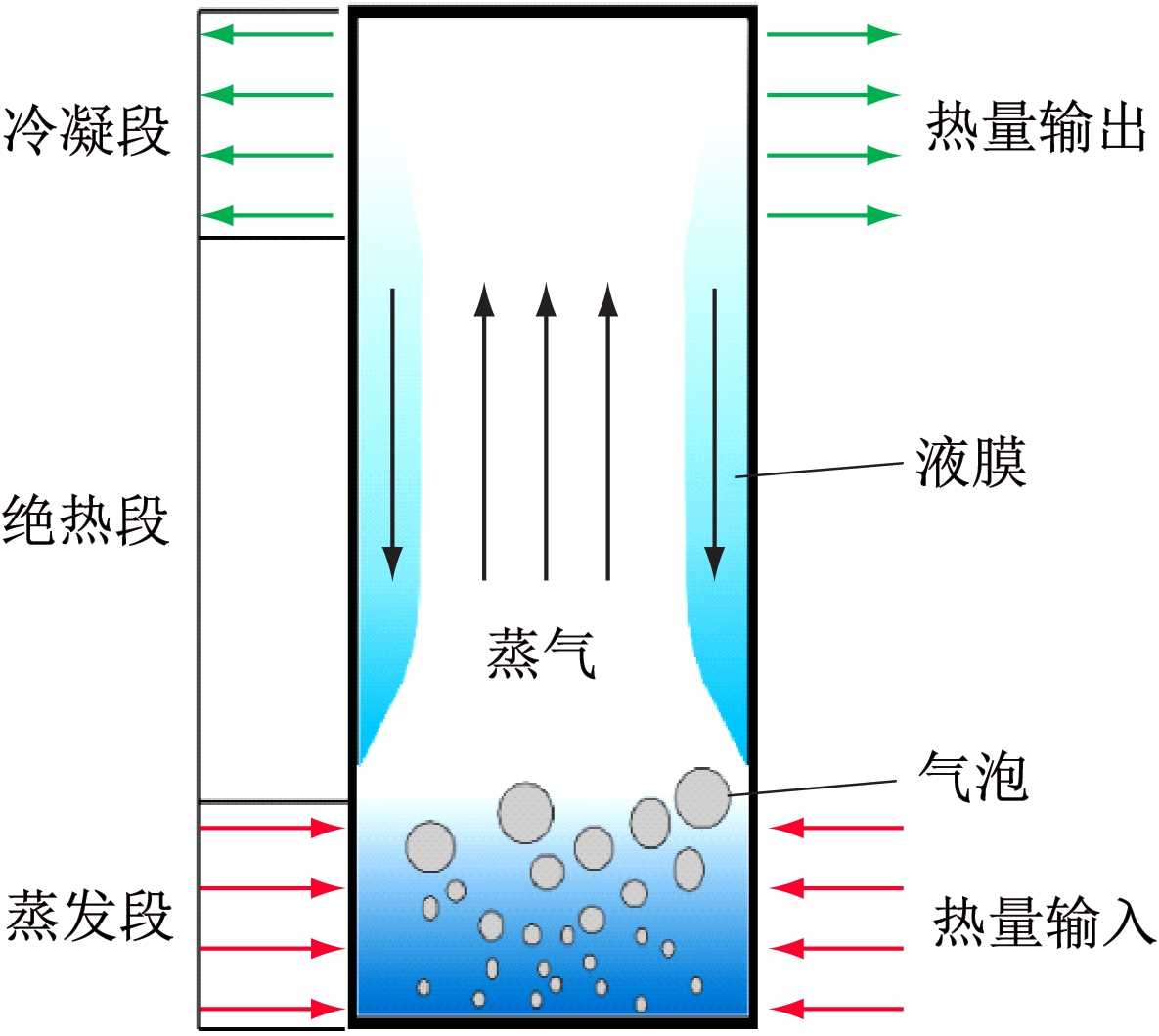
图1 重力热管原理
Fig.1 Principle of gravity heat pipe
2 数值模拟分析
2.1 物理模型及网格分布
基于储煤堆移热实验台,采用Comsol软件建立煤堆、热管和热源的物理模型。设置煤堆模型为1.2 m×1.2 m×1.2 m的多孔介质立方体,热源模型为半径为0.1 m的球体,重力热管模型为具有冷源属性的金属棒,如图2(a)所示。采用软件内置的网格控件将煤堆模型划分为自由三角形网格,完整网格共包含44 720个域单元、5 100个边界单元和516个边单元,如图2(b)所示。
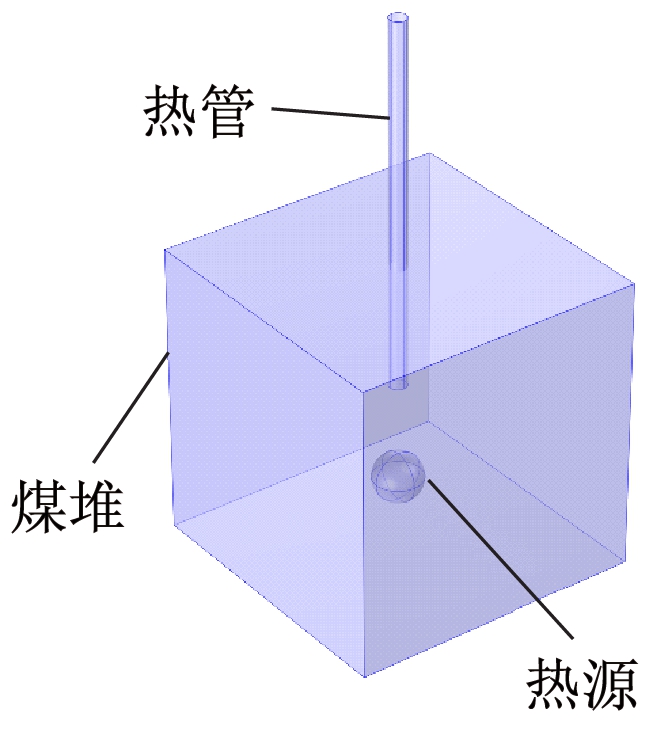
(a) 物理模型
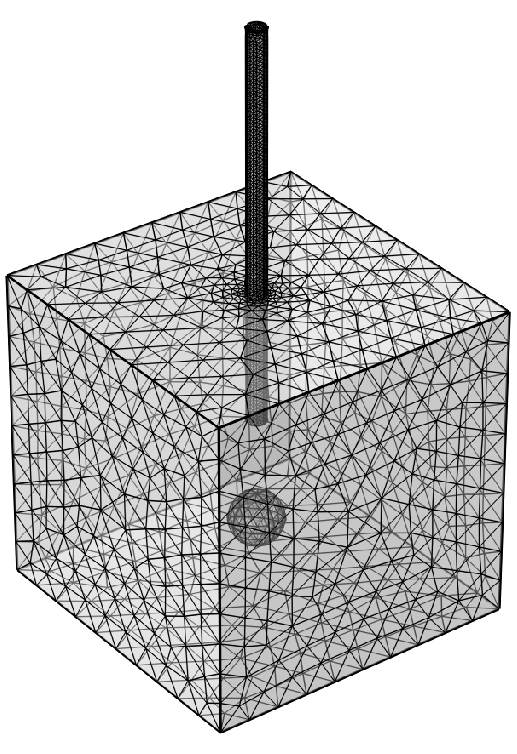
(b) 网格分布
图2 物理模型及网格分布
Fig.2 Physical model and grid distribution
2.2 边界条件和初始条件
设置热管外径为0.1 m,内径为0.05 m,长度为1.5 m;设煤堆初始温度为20 ℃,热源温度为130 ℃,外界环境温度为12 ℃;煤堆周围和热管边界采用自然对流换热,煤堆底部为热绝缘。
综合传热能力是重力热管的重要性能。本文引入等效导热系数λeff来等价描述重力热管的综合传热能力[16]:
(1)
式中:L为热管的总长度,m;λ为热管外壳的热导率,W/(m·K);d0为热管外径,m;di为热管内径,m;e=L1/L,f=L2/L,L1,L2分别为蒸发段和冷凝段长度,m;α1,α2分别为蒸发段和冷凝段的传热系数,W/(m2·K)。
部分材料属性及参数设置见表1。结合表1中的参数值,通过式(1)计算出等效导热系数。在Comsol软件中,设置重力热管的导热系数为等效导热系数。
表1 部分材料属性及参数设置
Table 1 Some material properties and parameter settings
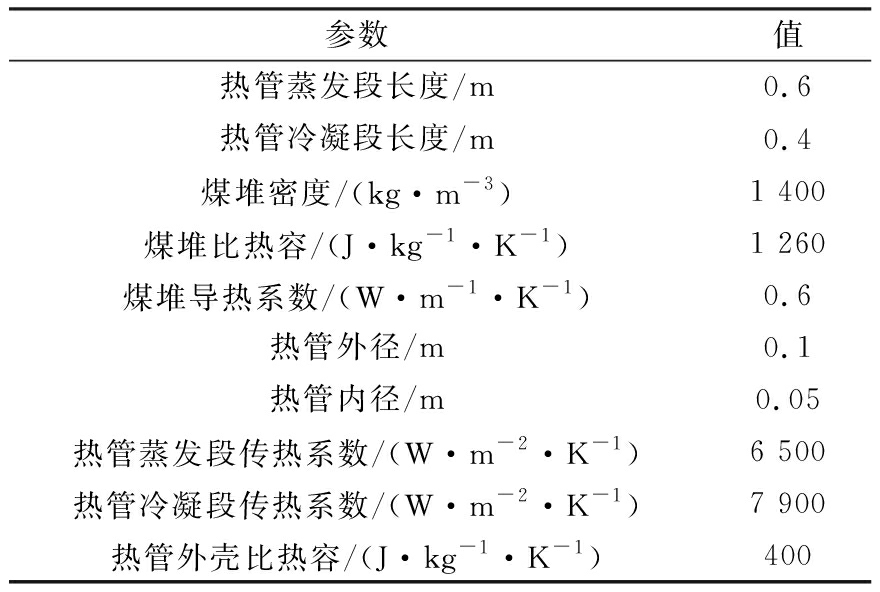
参数值热管蒸发段长度/m0.6热管冷凝段长度/m0.4煤堆密度/(kg·m-3)1 400煤堆比热容/(J·kg-1·K-1)1 260煤堆导热系数/(W·m-1·K-1)0.6热管外径/m0.1热管内径/m0.05热管蒸发段传热系数/(W·m-2·K-1)6 500热管冷凝段传热系数/(W·m-2·K-1)7 900热管外壳比热容/(J·kg-1·K-1)400
数值模拟包括加热和降温2个过程,在Comsol软件中设置求解步骤。步骤1:对无热管插入的煤堆进行加热,加热时长为48 h,得到煤堆高温热源点的温度值;步骤2:在煤堆中加入热管并禁用热源项,将步骤1得到的高温热源点温度的最后值作为初始值,模拟时长为24 h,每1 h记录1次测点温度数据。为了简化计算,不考虑煤堆的热辐射,采用瞬态求解方式求解高温热源点的温度。
2.3 数值模拟结果
煤堆高温热源点加热至一定温度后,将热管插入煤堆中,插入深度H分别取40,50,60 cm,插入倾角θ分别取30,45,60,90°,煤堆内部高温热源点温度变化的模拟值如图3所示。由图3可看出,煤堆降温过程可分为3个阶段,即大幅降温阶段、过渡阶段和缓慢降低阶段。以热管插入深度60 cm为例,0~5 h为大幅降温阶段,该阶段煤堆温度较高,外界环境温度较低,由于空气对流换热和热管换热的影响,高温热源点温度急剧下降;5~15 h为过渡阶段,煤堆降温速率变慢,这是因为煤堆温度降低,与外界温差减小,且随着煤堆温度降低,热管的工作效率也随之降低,从而导致降温速度减缓;15~24 h为缓慢降低阶段,由于煤堆温度降低,与外界环境温度接近,煤堆温度趋于稳定状态。
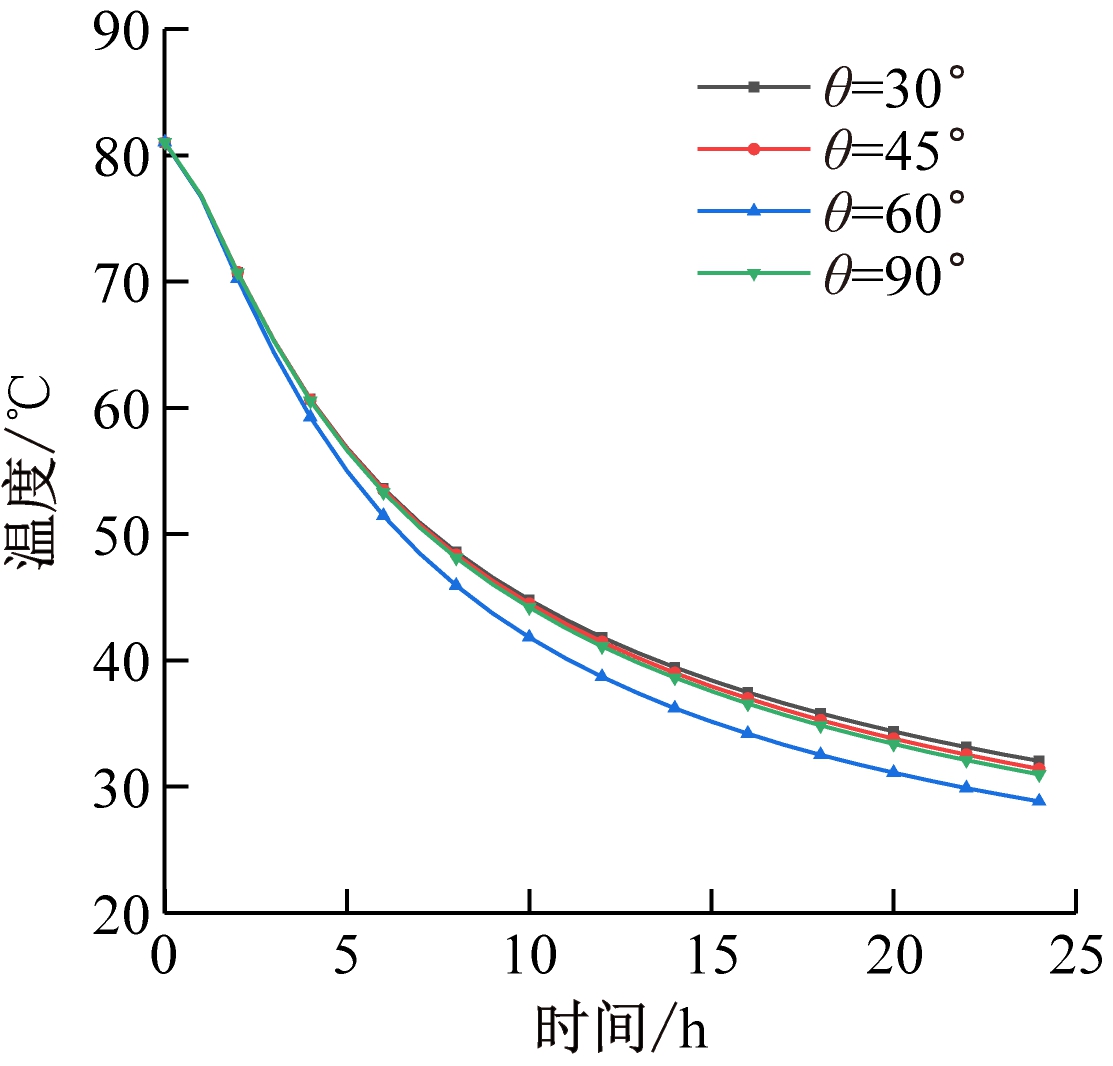
(a) H=40 cm
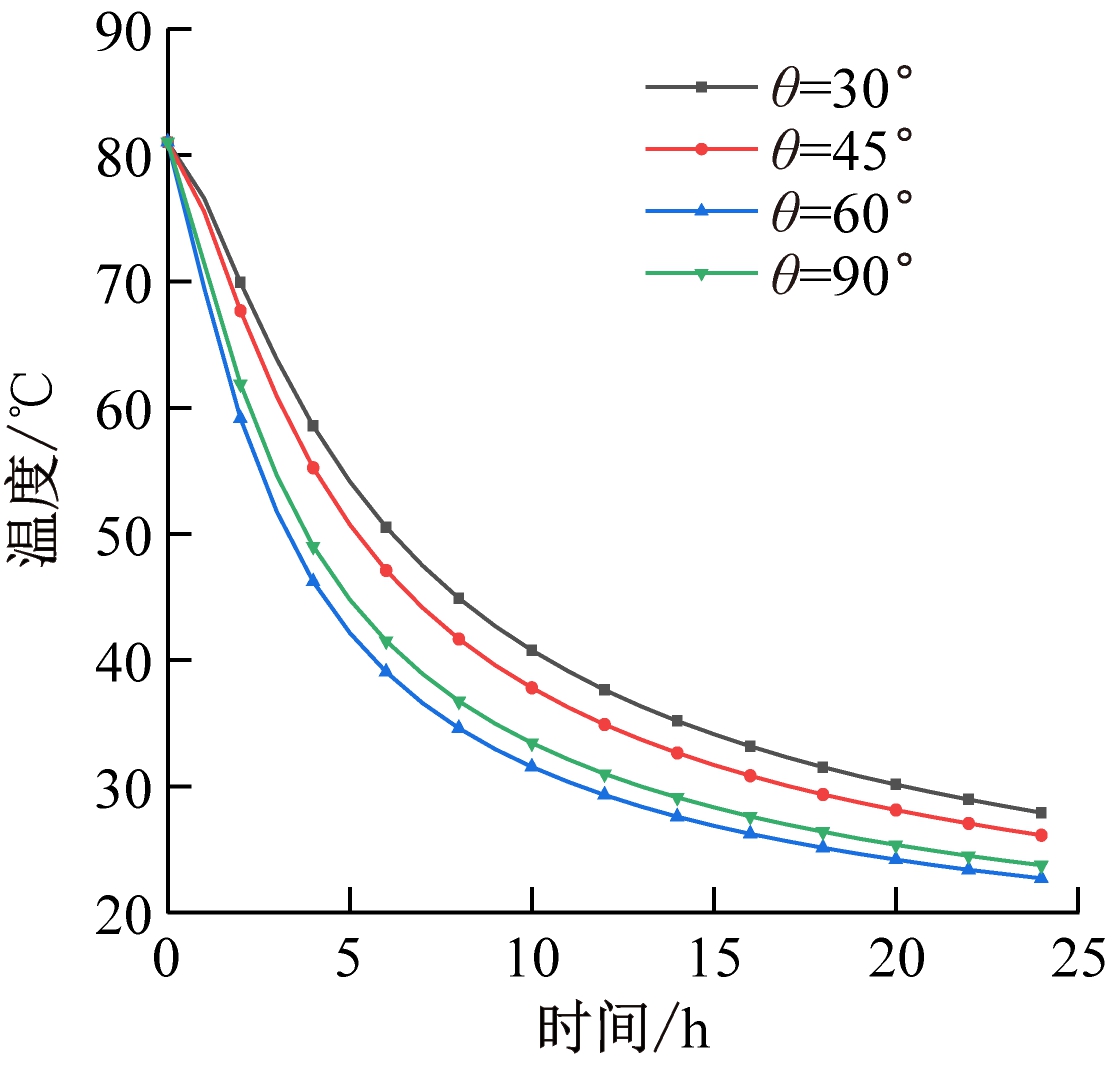
(b) H=50 cm
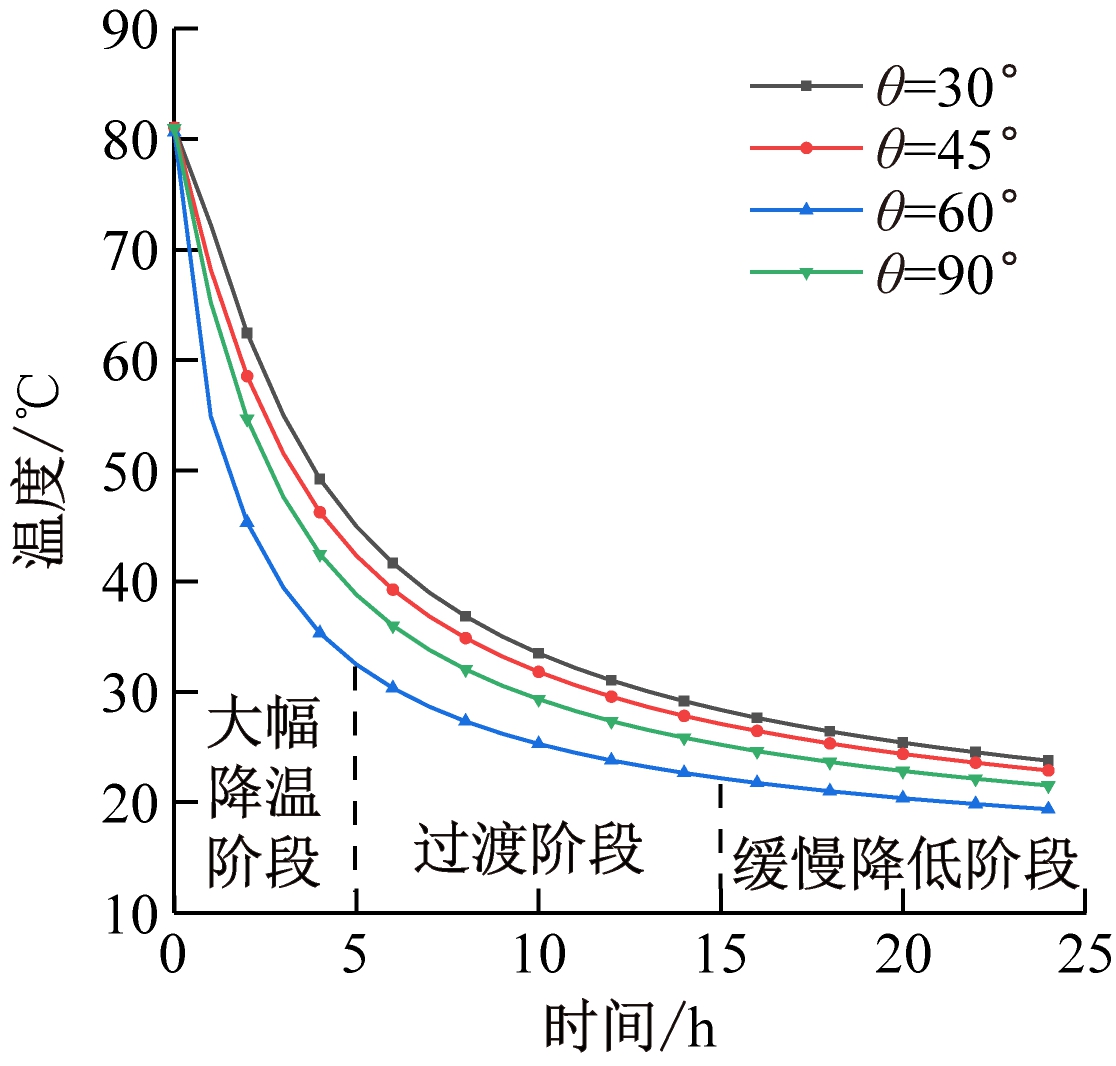
(c) H=60 cm
图3 不同布置方式下高温热源点温度变化的模拟值
Fig.3 Simulation values of temperature change of high temperature heat source point under different arrangements
不同布置方式下高温热源点的降温幅度对比如图4所示。可见,热管插入不同深度时温度变化较大,插入不同角度时温度变化较小,说明热管插入深度对煤堆内高温热源点的温度影响较大。这是由于热管插入深度较大时,热管底部距离煤堆高温热源点较近,热管工质液温度受高温热源点的影响较大,热管工作效率较高。另外,热管倾角为60°时降温效果最好,倾角为90°时次之,倾角为45°时的降温幅度大于30°时的降温幅度,这说明热管的倾角存在一个最佳值。这是由热管的工作原理导致的,当热管倾角较小时,蒸发段工质液受热面积较大,而作用在热管内部工质液的剪切力很小,导致工质液不能快速返回蒸发段,影响气液转化率,热管工作效率较低;当倾角逐渐增大时,管内气液两相流处于上下2层,互不冲突,当倾角达到60°时,内部达到动态平衡;当热管接近垂直放置时,随着倾角继续增大,管内的气液两相流处于反向运动状态,会产生较大的反向剪切力,从而影响热管的传热性能。
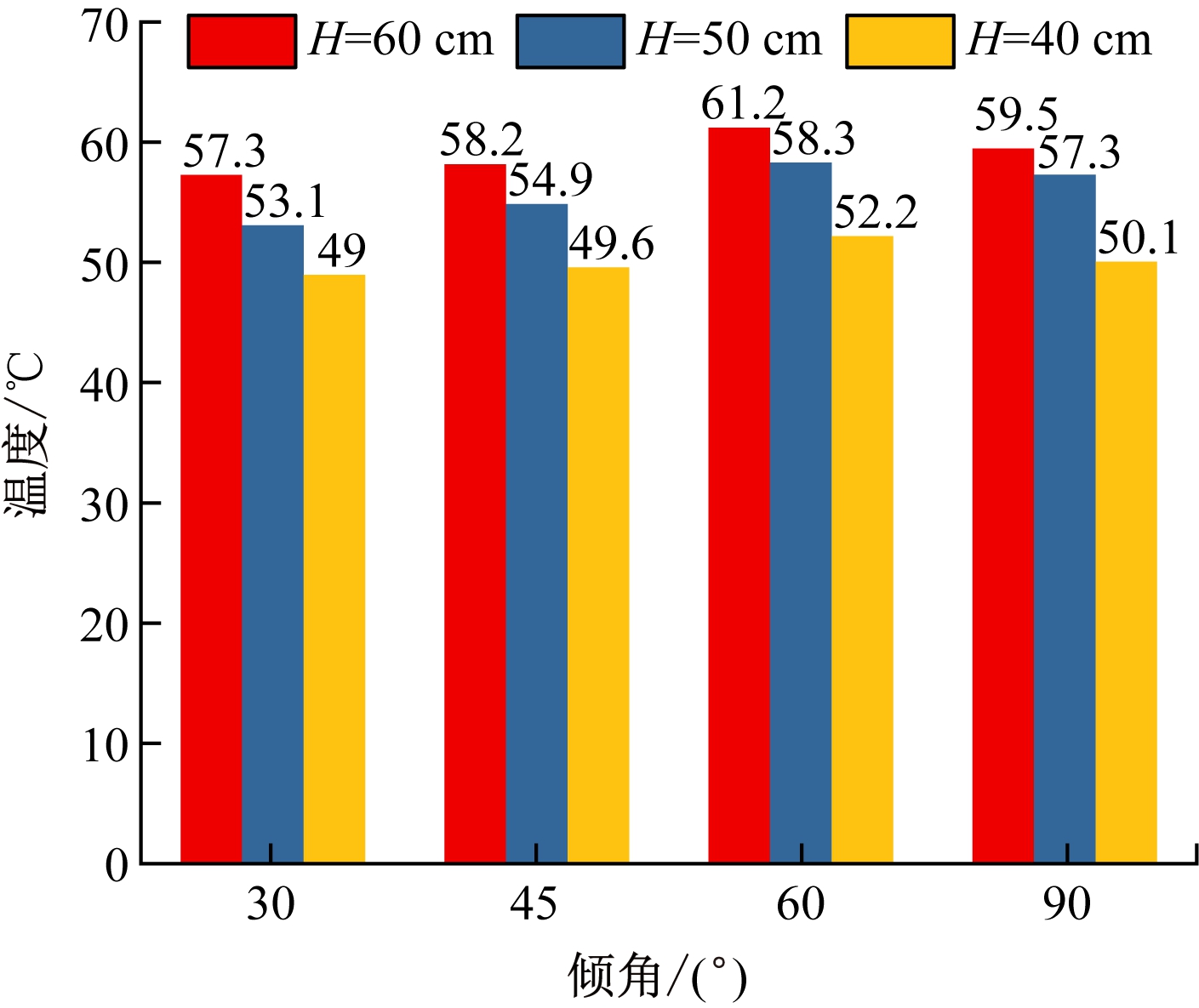
图4 不同布置方式下高温热源点的降温幅度对比
Fig.4 Comparison of cooling range of high temperature heat source point under different arrangements
由仿真结果可知,插入深度为60 cm、插入倾角为60°时,最高降温幅度达61.2 ℃,煤堆降温效果最好。
3 实验分析
为更加准确地分析重力热管的最佳布置方式,搭建了储煤堆移热实验台,如图5所示。该实验台由热管、储煤堆、热电偶、温度巡检仪和计算机组成,利用U型加热棒充当热源对煤堆进行加热,将热管布置在煤堆中,利用温度巡检仪对煤堆内部高温热源点温度进行实时监控,将温度巡检仪连接计算机,待高温点温度达到设定温度时停止加热并插入热管,监测24 h内热管的温度变化。
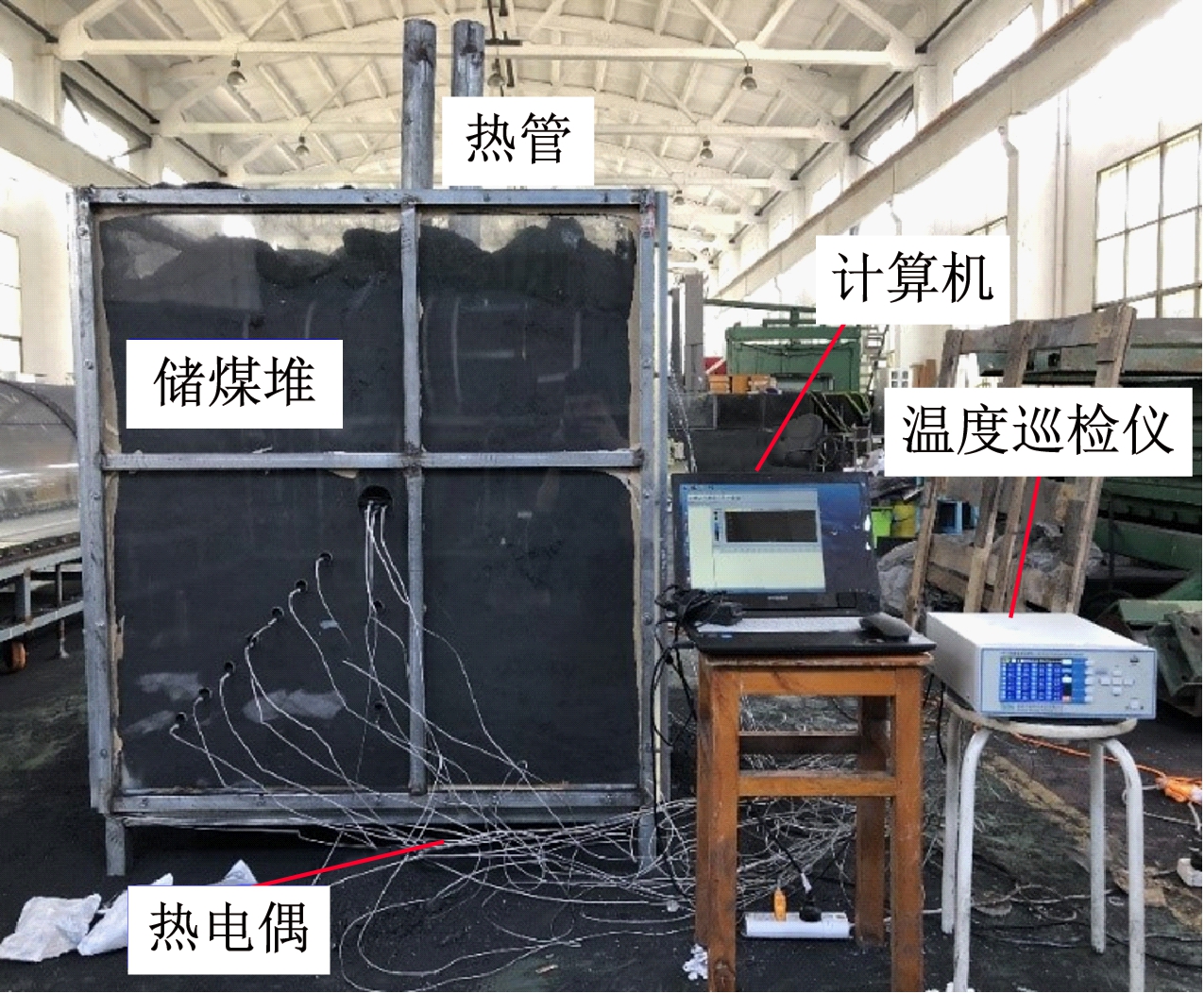
图5 储煤堆移热实验台
Fig.5 Heat transfer test bench for coal storage pile
不同布置方式下高温热源点温度变化的实验值如图6所示。
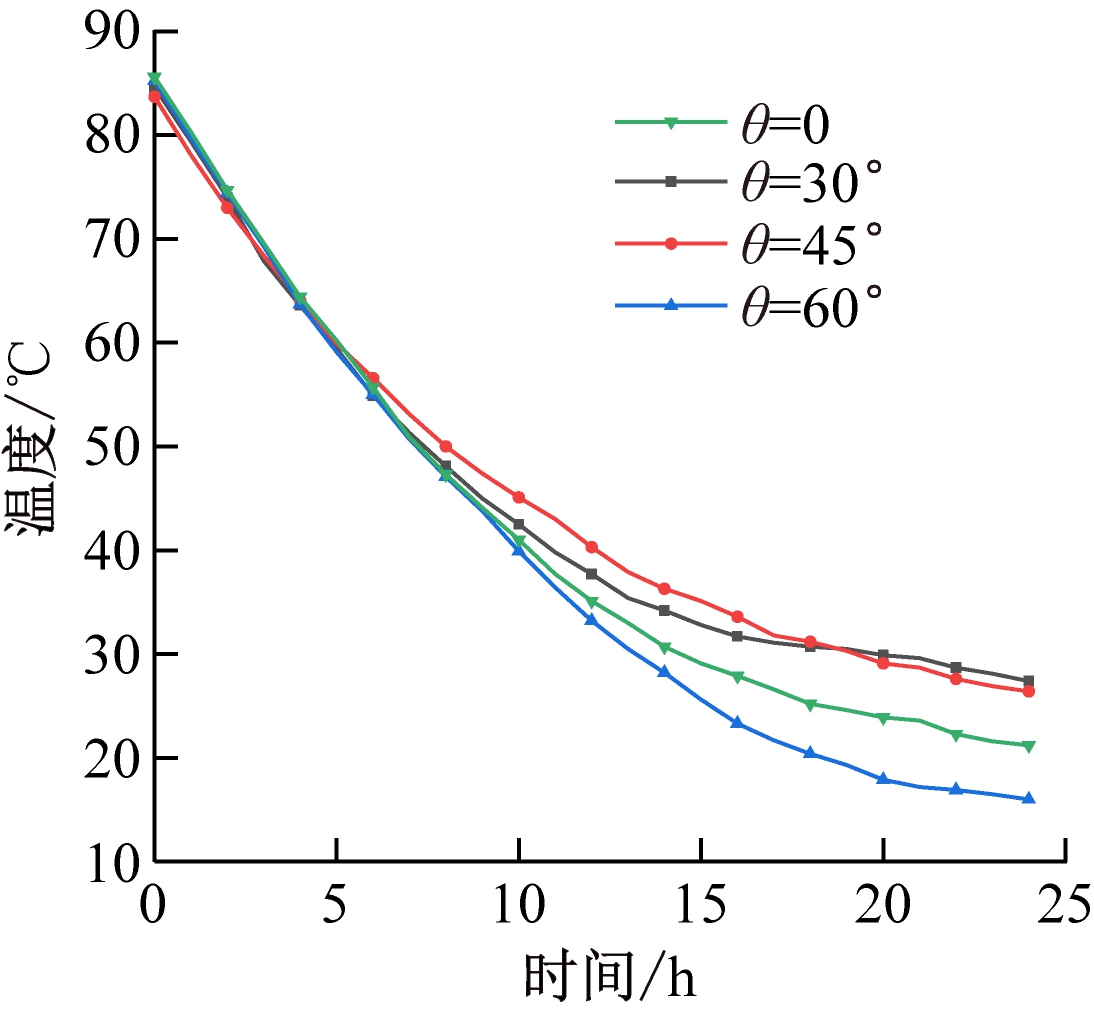
(a) H=60 cm
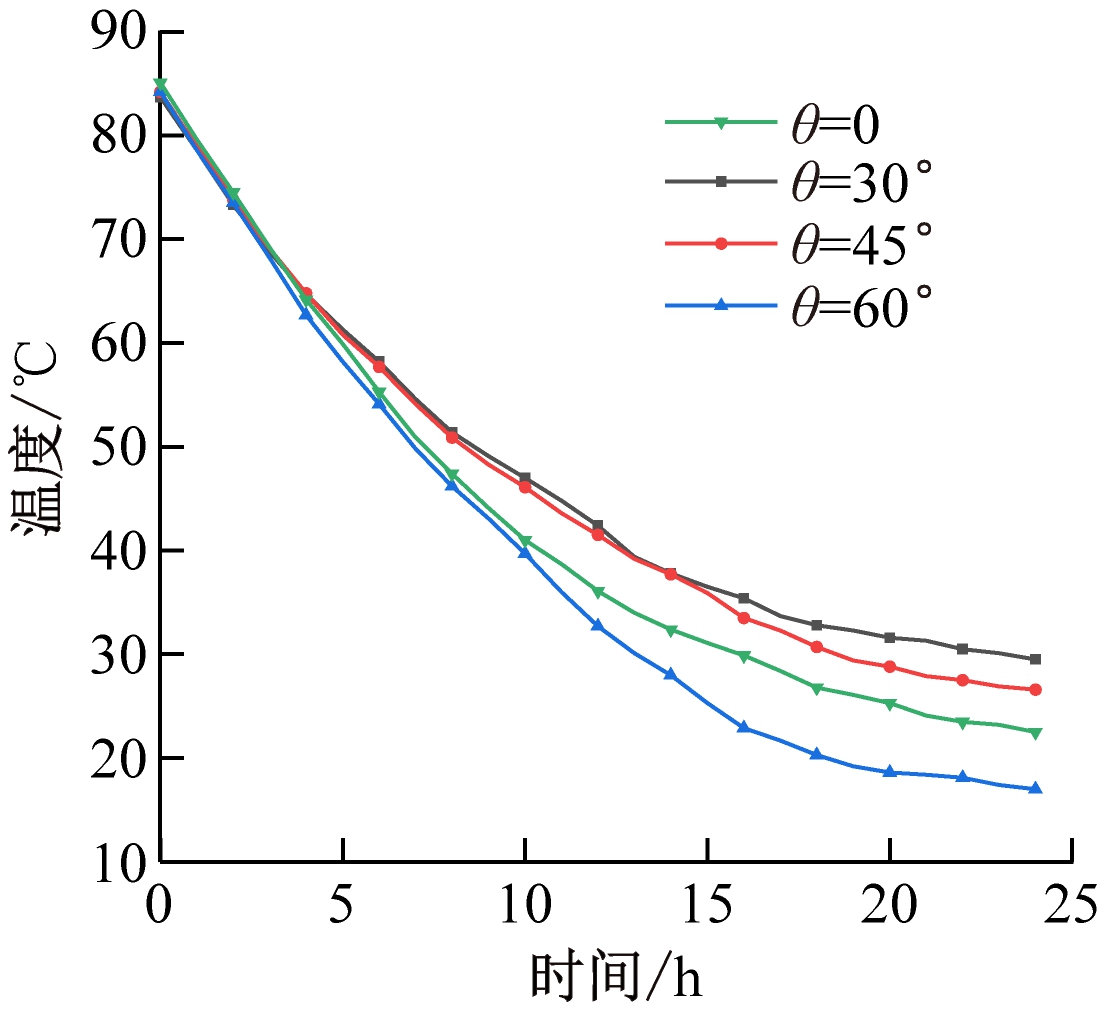
(b) H=50 cm
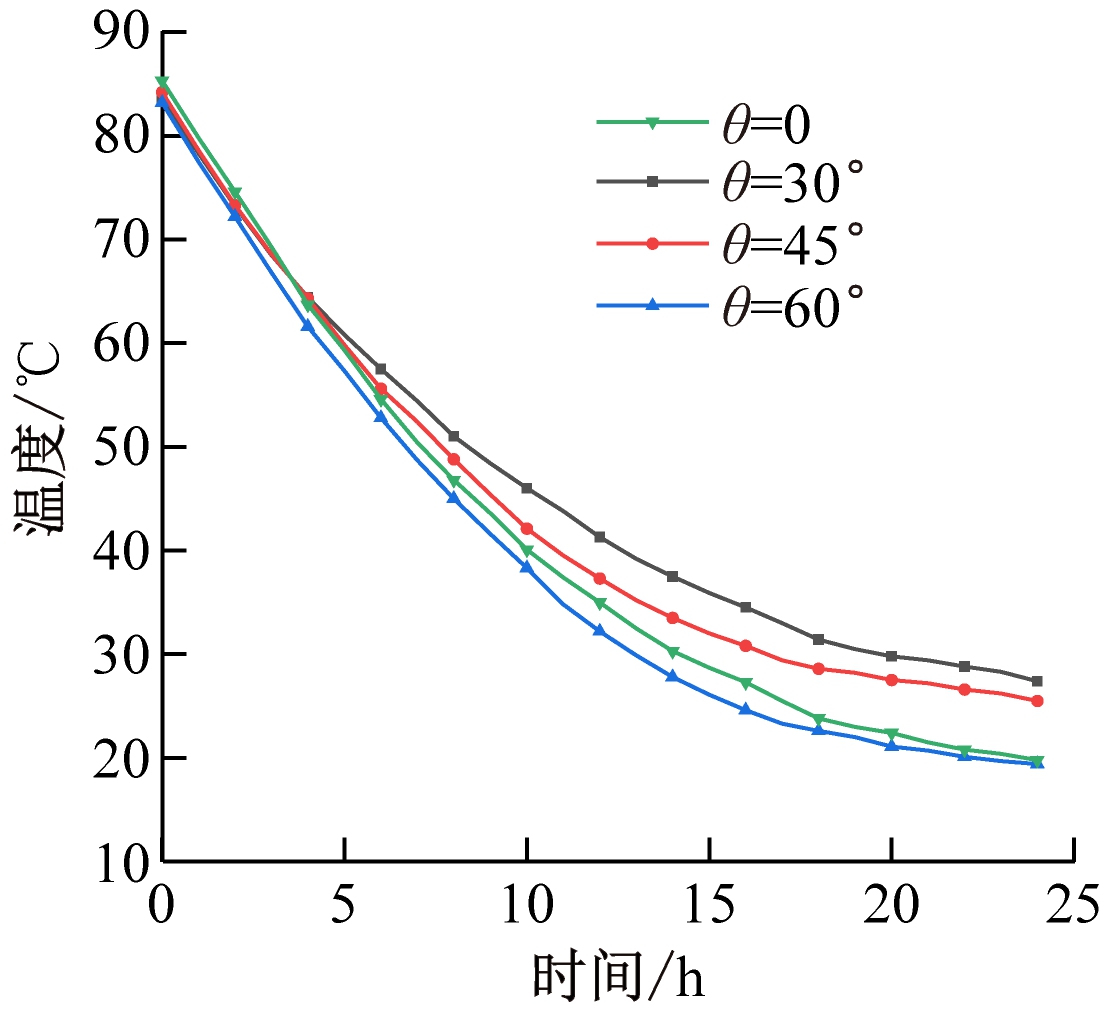
(c) H=40 cm
图6 不同布置方式下高温热源点温度变化的实验值
Fig.6 Experimental values of temperature change of high temperature heat source point under different arrangements
从图6可看出,当插入深度为60 cm、插入倾角为60°时,煤堆内部高温热源点的降温效果最好,实验结果与模拟结果一致。
热管降温速率模拟结果与实验结果对比如图7所示。可以看出,虽然不同布置方式下的实验数值与模拟数值具有一定差异,但除热管插入深度为40 cm时之外,整体趋势相近。从实验结果可看出,随着倾角增加,热管降温速率先减小、后增加;热管插入倾角为60°时,降温速率达到最大值。在实验过程中,热管插入深度为40 cm、倾角为90°时,高温热源点降温速率高于插入深度为50 cm和60 cm时的降温速率。这是由于实验过程周期较长,外界温差较大,空气与煤堆的对流换热加强,从而导致降温幅度与趋势不符。另外,由于数值模拟忽略了煤堆的含水率、环境风速及空气湿度变化等因素影响,其结果与实验结果有一定误差。
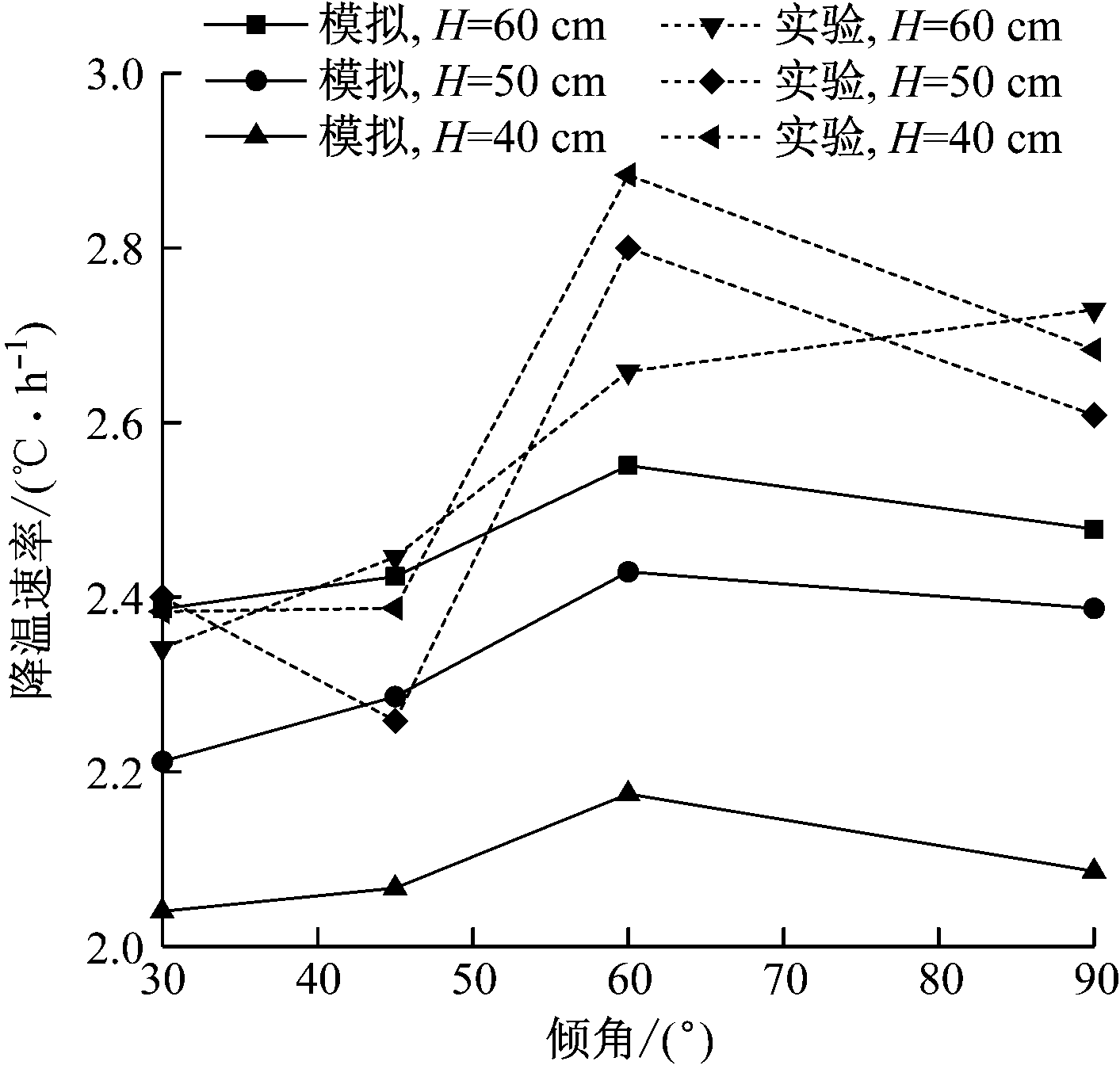
图7 热管降温速率模拟结果与实验结果对比
Fig.7 Comparison of simulation results and experimental results of cooling rate
4 结论
(1) 重力热管的布置方式对煤堆内部高温热源点有很大影响,且插入深度的影响大于插入倾角的影响。
(2) 在相同倾角下,重力热管布置深度越大越好,即距离热源越近越好;在相同深度下,重力热管布置倾角为60,90,45,30°时,降温幅度依次递减。
(3) 数值模拟与实验结果表明,重力热管插入深度为60 cm、插入倾角为60°时,降温速率达到最大值,降温效果最好。
[1] 文虎,郭军,金永飞,等.煤田火区高温氧化燃烧特性参数测试装置研发[J].工矿自动化,2015,41(3):14-18.
WEN Hu,GUO Jun,JIN Yongfei,et al.Development of testing device for characteristic parameters of high temperature oxidation combustion of coalfield fire area[J].Industry and Mine Automation,2015,41(3):14-18.
[2] 秦波涛,仲晓星,王德明,等.煤自燃过程特性及防治技术研究进展[J].煤炭科学技术,2021,49(1):66-99.
QIN Botao,ZHONG Xiaoxing,WANG Deming,et al.Research progress of coal spontaneous combustion process characteristics and prevention technology[J].Coal Science and Technology,2021,49(1):66-99.
[3] 白子明.防治煤自燃的微胶囊化复合阻化剂研究[D].徐州:中国矿业大学,2019.
BAI Ziming.Study on microencapsulated compound inhibitor for preventing coal spontaneous combustion[D].Xuzhou:China University of Mining and Technology,2019.
[4] 鲁义,王涛,田兆君,等.水泥基泡沫形成机理及抑制煤堆自燃试验研究[J].中国安全生产科学技术,2017,13(7):87-91.
LU Yi,WANG Tao,TIAN Zhaojun,et al.Test study on formation mechanism of cement-based foam and inhibition for spontaneous combustion of coal pile[J].Journal of Safety Science and Technology,2017,13(7):87-91.
[5] ZHU Tingting,DIAO Yanhua,ZHAO Yaohua,et al.Experimental study on the thermal performance and pressure drop of a solar air collector based on flat micro-heat pipe arrays[J].Energy Conversion and Management,2015,94:447-457.
[6] RAMOS J, CHONG A,JOUHARA H.Experimental and numerical investigation of a cross flow air-to-water heat pipe-based heat exchanger used in waste heat recovery[J].International Journal of Heat and Mass Transfer,2016,102:1267-1281.
[7] 王侃.基于热管技术的矿井透地通信主机散热结构设计[J].工矿自动化,2016,42(10):48-51.
WANG Kan.Design of heat dissipation structure of host computer of mine through-the-earth communication based on heat pipe technology[J].Industry and Mine Automation,2016,42(10):48-51.
[8] 党逸峰,张亚平,屈瑞,等.热管实现煤堆深部热转移的实验研究[J].煤炭技术,2016,35(12):214-215.
DANG Yifeng,ZHANG Yaping,QU Rui,et al.Experimental research of deep heat transfer using heat pipe for coal storage pile[J].Coal Technology,2016,35(12):214-215.
[9] 刘鑫,任万兴,石晶泰.导热棒提取松散高温介质内部热量的实验研究[J].煤矿安全,2021,52(2):48-53.
LIU Xin,REN Wanxing,SHI Jingtai.Experimental study on heat extraction of loose high temperature medium with heat conducting rod[J].Safety in Coal Mines,2021,52(2):48-53.
[10] 陈清华,孙美华,苏国用.重力热管对煤堆内部温度场的影响研究[J].煤矿安全,2018,49(11):211-214.
CHEN Qinghua,SUN Meihua,SU Guoyong.Influence of gravity heat hipe on temperature field in coal pile[J].Safety in Coal Mines,2018,49(11):211-214.
[11] 程方明,常助川,李贝,等.基于热棒降温技术的自燃煤堆热迁移行为数值模拟[J].西安科技大学学报,2019,39(4):581-588.
CHENG Fangming,CHANG Zhuchuan,LI Bei,et al.Numerical simulation on thermal migration behavior of spontaneous combustion coal pile based on heat pipe cooling technology[J].Journal of Xi'an University of Science and Technology,2019,39(4):581-588.
[12] 李贝,高伟,邓军,等.基于热棒防灭火技术的煤自燃区域热迁移特征[J].中南大学学报(自然科学版),2020,51(4):1135-1144.
LI Bei,GAO Wei,DENG Jun,et al.Thermal migration characteristics of coal fire area based on fire prevention technology with heat pipe[J].Journal of Central South University(Science and Technology),2020,51(4):1135-1144.
[13] 王皎.重力热管对煤堆自燃温度场分布影响效果的数值模拟研究[D].西安:西安科技大学,2018.
WANG Jiao.Numerical simulation study on effect of gravity heat pipe on distribution of coal fired spontaneous combustion temperature field[D].Xi'an:Xi'an University of Science and Technology,2018.
[14] 苏贺涛.基于重力热管换热的地下煤火治理与应用研究[D].徐州:中国矿业大学,2018.
SU Hetao.Study on underground coal fire control and application based on heat transfer using a gravity assisted heat pipe[D].Xuzhou:China University of Mining and Technology,2018.
[15] XIANG Gou,LI Guangyao,ZHANG Ruichen,et al.Critical and optimal inclination angles of two-phase closed thermosyphon under different operating conditions[J].International Journal of Heat and Mass Transfer,2021,177:121540.
[16] 唐志伟,俞昌铭,马重芳.热管性能评价准则探讨[J].北京工业大学学报,2003,29(1):55-58.
TANG Zhiwei,YU Changming,MA Chongfang.Exploration on ion on evaluation criterion of heat pipe performances[J].Journal of Beijing Polytechnic University,2003,29(1):55-58.
